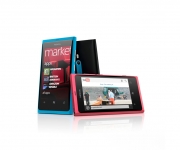By
Nokia
Nokia
Designed in
Finland
Description
The Nokia Lumia 800 is a completely new smartphone design aesthetic combining beautifully crafted hardware with a well-conceived user interface.
The first product from the alliance between Nokia and Microsoft's R&D; teams, it demonstrates the heights both companies have gone to produce a standout smartphone that is classy, incredibly satisfying to use, fast and coherent.
Every feature of the phone, either physical or digital, is driven solely by the end user experience. Nokia has focused on the essentials - design and simplicity, while ensuring the highest-possible build and reception quality. Furthermore, the use of sustainable materials helps reduce environmental impact.
Key Features
and/or Benefits
Nokia Lumia 800 design story. Nic Healey, PC & Tech Authority: "This is a superbly designed phone..."
The sleek, curved casing, together with the inky blackness of the glass and precision finishing is unlike any other smartphone available today.
Its shell is made from a single piece of injection-moulded polycarbonate.
The design process involved post-processing techniques normally reserved for metals which ensured higher precision and smaller tolerances between the display, glass and body.
The use of polycarbonate also provides an important functional benefit - outstanding antennae performance, which means users won't drop calls.
Available in matt-black, cyan, magenta and white, the colour pigment runs right through the phone's polycarbonate body so if it gets scratched, it's virtually impossible to tell.
The polycarbonate body is the same material used in ice-hockey helmets, so it's extremely durable.
Strong glass, finished with a protective coating minimises scratches and helps you keep the surface clean.
Easy-to-use and intuitive interface. Joseph Hanlon, CNET: "ClearBlack makes things easier to see on the screen, especially outdoors, and we have to agree with this..."
Inspired by public wayfinding systems and travel iconography, the Windows Phone interface looks different and sets a new benchmark in usability.
Bold graphics, clear typography and logical navigation means users spend less time working out what to do and more time interacting with the world around them.
The homescreen is a grid of live, animated tiles providing up-to-the-minute feeds from social network updates and news to email and calendar alerts. Each tile can be tailored for access to the apps most used: music playlists, games, websites...
There are also many security features that will protect the user in case of loss or theft. The phone can be password protected and after multiple attempts with the wrong password, the phone will wipe. You can also lock or wipe the phone remotely through various applications.
And there are other security features including Information Rights Management email and Sandboxing preventing one application harming others.
Many of these insights went into shaping the hardware design and UI and took into account current and emerging behaviour - particularly where it might translate into the mainstream.
Locally, the Lumia 800 has received overwhelmingly positive feedback. Independent consumer groups had an emotional rather than functional connection with the phone, with users describing the design as unique, stylish and elegant.

